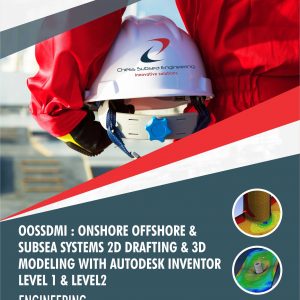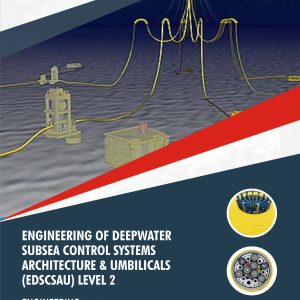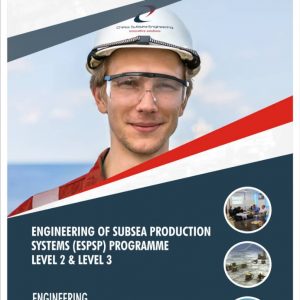Description
The “Engineering of Subsea Pipelines from Conception to Detailed Design Level 1 to Level 3” course is a comprehensive program that covers the entire process of designing subsea pipelines, starting from the initial conceptualization stage and progressing to the detailed design phase. It is designed to provide participants with a thorough understanding of the engineering principles, industry standards, and best practices involved in subsea pipeline design.
The course is typically divided into three levels, each focusing on specific aspects of the pipeline engineering process:
At this level, participants will be introduced to the fundamental concepts and considerations involved in the conception and planning of subsea pipelines. Topics covered may include offshore field development, route selection, geotechnical investigations, environmental assessments, and regulatory requirements. Participants will gain insights into the project management aspects and learn how to conduct feasibility studies and preliminary engineering assessments.
In Level 2, the course delves into the detailed engineering and design phase of subsea pipelines. Participants will learn about pipeline materials selection, corrosion protection methods, pipeline routing, stability analysis, stress analysis, and structural design considerations. They will also gain knowledge about pipeline installation techniques, including trenching, plowing, and laying methods. Subsea equipment and components such as risers, manifolds, and subsea connectors may also be covered.
The final level focuses on advanced topics related to the design and integrity management of subsea pipelines. Participants will learn about advanced pipeline design techniques, such as fatigue analysis, fracture mechanics, and dynamic response analysis. The course may also cover pipeline integrity management, including inspection and maintenance strategies, risk assessment, and anomaly detection. Topics related to pipeline decommissioning and abandonment may also be discussed.
Engineering of Subsea Pipelines from Conception to Detailed Design Level 1 to Level 3 covers Different Phases in a Submarine Pipeline Project, DNV Standard (Limit State Design Methodology), Route Selection Study Flow Assurance Study Material & Grade Selection , Pipe Manufacturing, Pipe Anti-corrosion Coating & CP Design, Wall Thickness Calculation, Local Buckling Criteria – Combined Loading, Fracture Criteria, On-bottom Stability of Pipeline, Pipeline Installation Studies, Shore Approach Design, Free Span Analysis, Riser Design – Rigid Pipeline, Practical Hands On Workshop Design of Two Subsea Production Pipelines and more
Course Outlines
Relevant Codes & Standards
Different Phases in a Submarine Pipeline Project
DNV Standard Limit State Design Methodology
Limit State Criteria
Subsea Pipeline Stress Analysis
Pipeline Stress Components
Hoop Stress
Longitudinal Stress
Equivalent Stress
Hydrostatic Collapse
Stress-Strain Relationship For Pipelines
Horizontal Pipeline Stability
Vertical Pipeline Stability
Pipeline Free Spans
Vortex Induced Vibration (VIV)
Upheaval And Lateral Buckling
Driving Force For Upheaval Buckling
Effective Expansion Force in DNV Codes
Upheaval Buckling Failure Modes
Strategies For Analysis Of Upheaval Buckling Movements
Upheaval Buckling Preventing Measures
Upheaval Buckling Corrective Actions
Lateral Buckling
Lateral Buckling
Management of Lateral Buckling
Uplift Resistance Cohesion And Non Cohesionless Soil
Uplift Resistance Non Cohesionless Soil
Uplift Resistance Cohesionless Soil
Brief Look At Upheaval Buckling Design According to DET Norske Veritas
Design Process For Buried Pipelines Based On DNV-RP-F110
Buried Subsea Pipeline
Purpose Of Buring Pipelines
Installation Of Subsea Buried Pipelines
Jetting
Mechanical Cutting
Buried Subsea Pipelines Backfill (Covers)
Cohesive Soil
This workshop describes the review of the preliminary design of the production pipelines for two new subsea developments, A field and B field, that tie back to the Bridge Linked Platform (BLP). The A field is a gas condensate development that comprises a drill centre with three production wells with gas lift approximately 10km southwest of the BLP. Production is to be transported to the BLP by an 8”/14” insulated pipe-in-pipe system – Pipeline A. The B field is to be developed with separate production and water injection drill centres. Oil with formation gas from the production drill centre approximately 17km south of the BLP is to be transported by a single 10” wet-insulated pipeline – Pipeline B. Both pipelines cross a buried oil export line and Pipeline A also crosses a trunk line on the seabed.
This workshop shall include an assessment of the available geotechnical survey data to characterize the soils along the pipeline route and to ascertain whether there is sufficient information to perform an on-bottom stability analysis.
 Loading...
Loading...
As both pipelines are to be trenched and buried, the available methods shall be compared and a recommendation made for each route. In addition, the proposed pipeline configurations shall be reviewed against the pressure containment and upheaval buckling requirements of the appropriate DNV codes.
Crossings of the existing pipelines shall be designed and assessed for upheaval buckling. Finally, ancillary equipment required to produce multiple wells through a single pipeline shall be described and safety considerations for all aspects will be highlighted.
The The following investigation and calculations shall be performed as shown below:
Site Investigation
Positioning on Seabed
Wall Thickness Design Check
Upheaval Buckling Assessment
Crossing Design
Subsea Facilities
Safety Considerations
Reference code
DNVGL-ST-F101 Submarine pipeline systems
DNVGL-RP-C205 (Environmental conditions and environmental loads),
DNVGL-RP-F101 (Corroded pipelines),
DNVGL-RP-F102 (Pipeline field joint coating and field repair of linepipe coating),
DNVGL-RP-F103 (Cathodic protection of submarine pipelines),
DNVGL-RP-F105 (Free spanning pipelines),
DNVGL-RP-F106 (Factory applied external pipeline coatings for corrosion control),
DNVGL-RP-F107 (Risk assessment of pipeline protection),
DNVGL-RP-F108 (Assessment of flaws in pipeline and riser girth welds),
DNVGL-RP-F109 (On-bottom stability design of submarine pipelines),
DNVGL-RP-F110 (Global buckling of submarine pipelines),
DNVGL-RP-F111 (Interference between trawl gear and pipelines),
DNVGL-RP-F113 (Pipeline subsea repair),
DNVGL-RP-F114 (Pipe-soil interaction for submarine pipelines),
DNVGL-RP-F115 (Pre-commissioning of submarine pipelines),
DNVGL-RP-F116 (Integrity management of submarine pipeline systems),
DNVGL-RP-O501 (Managing sand production and erosion)
Technical Support Sectional Reference
Offshore field development
Role of subsea pipelines in oil and gas transportation
Factors influencing route selection
Environmental impact assessments and mitigation strategies
Geotechnical investigations and soil conditions
Relevant regulatory frameworks and guidelines
Permitting and approval processes
Project scoping and feasibility assessments
Preliminary cost estimation and economic analysis
Conceptual design considerations
Project planning and scheduling
Risk management and mitigation strategies
Stakeholder engagement and communication
Pipeline material properties and selection criteria
Coating and cathodic protection methods
Corrosion monitoring and mitigation techniques
Route optimization and selection criteria
Pipeline stability analysis and lateral buckling considerations
Subsea terrain analysis and geohazard assessments
Pipeline stress analysis methods
Design considerations for bending, axial, and thermal loads
Subsea pipeline supports and buoyancy control
Trenching, plowing, and laying methods
Subsea equipment and installation vessels
Pipeline pre-commissioning and testing
Risers, manifolds, and subsea connectors
Flow assurance and hydrate management
Subsea control systems and umbilicals
Fatigue analysis and design life considerations
Fracture mechanics and crack growth analysis
Dynamic response analysis and pipeline integrity under extreme conditions
Inspection and maintenance strategies
Risk assessment and integrity assessment methodologies
Anomaly detection and mitigation techniques
Regulatory requirements and decommissioning plans
Pipeline plugging and abandonment techniques
Environmental considerations and site restoration
Advances in subsea pipeline materials and coatings
Innovative installation techniques and equipment
Digitalization and automation in subsea pipeline engineering
Assessment
Participant underpinning knowledge of subsea pipeline engineering will be accessed with short answer multiple-choice questionnaire and case studies at the conclusion of the course.
Outcome
Participants will gain an in debt understanding of Subsea Pipeline Engineering & Tie In Components. They will also be able to function with minimum supervision as a Subsea SURFs Engineer or Subsea Pipeline Engineer for IOCs, subsea pipeline company contractor, vendor or installation company.
Professional Certificate
Issued directly by Chess Subsea Engineering Europe.
Participant may be presented for Offshore Petroleum Training Organization (OPITO) Certification.
How to Register
Click here to download registeration booklet on msword and email completed booklet to info@chesssubseaengineering.org directly.










